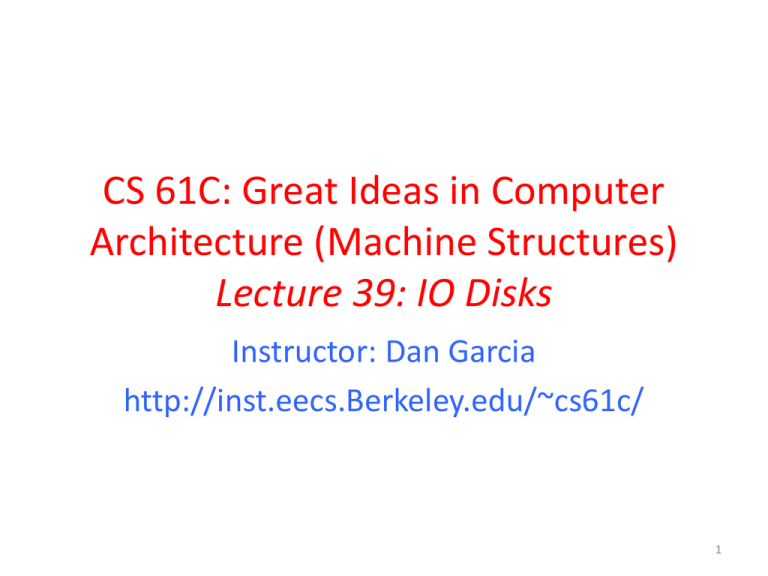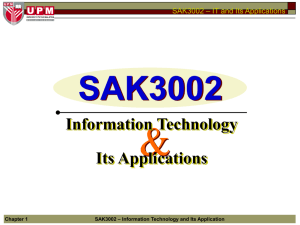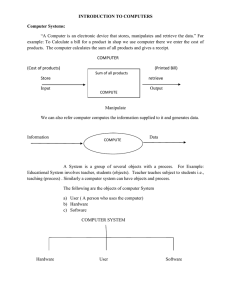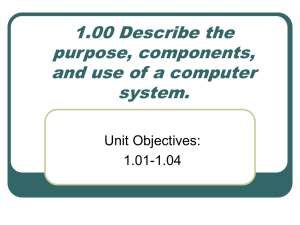2014Sp-CS61C-L39-dg
advertisement

CS 61C: Great Ideas in Computer Architecture (Machine Structures) Lecture 39: IO Disks Instructor: Dan Garcia http://inst.eecs.Berkeley.edu/~cs61c/ 1 Review - 6 Great Ideas in Computer Architecture 1. 2. 3. 4. 5. 6. Layers of Representation/Interpretation Moore’s Law Principle of Locality/Memory Hierarchy Parallelism Performance Measurement & Improvement Dependability via Redundancy 4 Review - Great Idea #6: Dependability via Redundancy • Redundancy so that a failing piece doesn’t make the whole system fail 1+1=2 1+1=2 2 of 3 agree 1+1=2 1+1=1 FAIL! Increasing transistor density reduces the cost of redundancy 5 Review - Great Idea #6: Dependability via Redundancy • Applies to everything from datacenters to memory – Redundant datacenters so that can lose 1 datacenter but Internet service stays online – Redundant routes so can lose nodes but Internet doesn’t fail – Redundant disks so that can lose 1 disk but not lose data (Redundant Arrays of Independent Disks/RAID) – Redundant memory bits of so that can lose 1 bit but no data (Error Correcting Code/ECC Memory) 6 Magnetic Disk – common I/O device • A kind of computer memory – Information stored by magnetizing ferrite material on surface of rotating disk • similar to tape recorder except digital rather than analog data • Nonvolatile storage – retains its value without applying power to disk. • Two Types – Floppy disks – slower, less dense, removable. – Hard Disk Drives (HDD) – faster, more dense, non-removable. • Purpose in computer systems (Hard Drive): – Long-term, inexpensive storage for files – “Backup” for main-memory. Large, inexpensive, slow level in the memory hierarchy (virtual memory) 7 Photo of Disk Head, Arm, Actuator Spindle Arm Head Actuator Platters (1-12) 8 Disk Device Terminology Arm Head Platter Sector Inner Track Outer Track Actuator • Several platters, with information recorded magnetically on both surfaces (usually) • Bits recorded in tracks, which in turn divided into sectors (e.g., 512 Bytes) • Actuator moves head (end of arm) over track (“seek”), wait for sector rotate under head, then read or write 9 Where does Flash memory come in? • Microdrives and Flash memory (e.g., CompactFlash) are going head-to-head – Both non-volatile (no power, data ok) – Flash benefits: durable & lower power (no moving parts, need to spin µdrives up/down) – Flash limitations: finite number of write cycles (wear on the insulating oxide layer around the charge storage mechanism). Most ≥ 100K, some ≥ 1M W/erase cycles. • How does Flash memory work? – NMOS transistor with an additional conductor between gate and source/drain which “traps” electrons. The presence/absence is a 1 or 0. en.wikipedia.org/wiki/Flash_memory 10 en.wikipedia.org/wiki/Ipod www.apple.com/ipod What does Apple put in its iPods? Toshiba flash 2 GB Samsung flash Toshiba 1.8-inch HDD Toshiba flash 16 GB 80, 120, 160 GB 32, 64 GB shuffle, nano, classic, touch 11 Use Arrays of Small Disks… • Katz and Patterson asked in 1987: • Can smaller disks be used to close gap in performance between disks and CPUs? Conventional: 4 disk 3.5” 5.25” designs Low End 10” 14” High End Disk Array: 1 disk design 3.5” 12 Replace Small # of Large Disks with Large # of Small! (1988 Disks) Capacity Volume Power Data Rate I/O Rate MTTF Cost IBM 3390K IBM 3.5" 0061 x70 20 GBytes 320 MBytes 23 GBytes 97 cu. ft. 11 cu. ft. 9X 0.1 cu. ft. 3 KW 1 KW 11 W 3X 15 MB/s 120 MB/s 8X 1.5 MB/s 600 I/Os/s 55 I/Os/s 3900 I/Os/s 6X 250 KHrs ??? Hrs 50 KHrs $250K $150K $2K Disk Arrays potentially high performance, high MB per cu. ft., high MB per KW, but what about reliability? 13 Replace Small # of Large Disks with Large # of Small! (1988 Disks) Capacity Volume Power Data Rate I/O Rate MTTF Cost IBM 3390K IBM 3.5" 0061 x70 20 GBytes 320 MBytes 23 GBytes 97 cu. ft. 11 cu. ft. 9X 0.1 cu. ft. 3 KW 1 KW 11 W 3X 15 MB/s 120 MB/s 8X 1.5 MB/s 600 I/Os/s 55 I/Os/s 3900 I/Os/s 6X 250 KHrs ??? Hrs 50 KHrs $250K $150K $2K Disk Arrays potentially high performance, high MB per cu. ft., high MB per KW, but what about reliability? 14 Array Reliability • Reliability - whether or not a component has failed – measured as Mean Time To Failure (MTTF) • Reliability of N disks = Reliability of 1 Disk ÷ N (assuming failures independent) – 50,000 Hours ÷ 70 disks = 700 hour • Disk system MTTF: Drops from 6 years to 1 month! • Disk arrays too unreliable to be useful! 15 Redundant Arrays of (Inexpensive) Disks • Files are “striped” across multiple disks • Redundancy yields high data availability – Availability: service still provided to user, even if some components failed • Disks will still fail • Contents reconstructed from data redundantly stored in the array Capacity penalty to store redundant info Bandwidth penalty to update redundant info 16 RAID : Redundant Array of Inexpensive Disks • Invented @ Berkeley (1989) • A multi-billion industry 80% non-PC disks sold in RAIDs • Idea: – Files are “striped” across multiple disks – Redundancy yields high data availability • Disks will still fail – Contents reconstructed from data redundantly stored in the array • • Capacity penalty to store redundant info Bandwidth penalty to update redundant info 17 “RAID 0”: No redundancy = “AID” • Assume have 4 disks of data for this example, organized in blocks • Large accesses faster since transfer from several disks at once This and next 5 slides from RAID.edu, http://www.acnc.com/04_01_00.html http://www.raid.com/04_00.html also has a great tutorial 18 RAID 1: Mirror data • Each disk is fully duplicated onto its “mirror” – Very high availability can be achieved • Bandwidth reduced on write: – 1 Logical write = 2 physical writes • Most expensive solution: 100% capacity overhead 19 RAID 3: Parity • Spindles synchronized, each sequential byte on a diff. drive • Parity computed across group to protect against hard disk failures, stored in P disk • Logically, a single high capacity, high transfer rate disk • 25% capacity cost for parity in this example vs. 100% for RAID 1 (5 disks vs. 8 disks) • Q: How many drive failures can be tolerated? 20 Inspiration for RAID 5 (RAID 4 block-striping) • Small writes (write to one disk): – Option 1: read other data disks, create new sum and write to Parity Disk (access all disks) – Option 2: since P has old sum, compare old data to new data, add the difference to P: 1 logical write = 2 physical reads + 2 physical writes to 2 disks • Parity Disk is bottleneck for Small writes: Write to A0, B1 both write to P disk (RAID 4 block-striping) A0 B0 C0 D0 P A1 B1 C1 D1 P 21 RAID 5: Rotated Parity, faster small writes • Independent writes possible because of interleaved parity – Example: write to A0, B1 uses disks 0, 1, 4, 5, so can proceed in parallel – Still 1 small write = 4 physical disk accesses 22 “And in conclusion…” • I/O gives computers their 5 senses • I/O speed range is 100-million to one • Processor speed means must synchronize with I/O devices before use: Polling vs. Interrupts • Networks are another form of I/O • Protocol suites allow networking of heterogeneous components – Another form of principle of abstraction • RAID – Higher performance with more disk arms per $ – More disks == More disk failures – Different RAID levels provide different cost/speed/reliability tradeoffs 25 Bonus: Disk Device Performance (1/2) Outer Inner Sector Head ArmController Spindle Track Track Platter Actuator • Disk Latency = Seek Time + Rotation Time + Transfer Time + Controller Overhead – Seek Time? depends on no. tracks to move arm, speed of actuator – Rotation Time? depends on speed disk rotates, how far sector is from head – Transfer Time? depends on data rate (bandwidth) of disk (f(bit density,rpm)), size of request 26 Bonus: Disk Device Performance (2/2) • Average distance of sector from head? • 1/2 time of a rotation – 7200 Revolutions Per Minute 120 Rev/sec – 1 revolution = 1/120 sec 8.33 milliseconds – 1/2 rotation (revolution) 4.17 ms • Average no. tracks to move arm? – Disk industry standard benchmark: • Sum all time for all possible seek distances from all possible tracks / # possible • Assumes average seek distance is random • Size of Disk cache can strongly affect perf! – Cache built into disk system, OS knows nothing 27 BONUS : Hard Drives are Sealed. Why? • The closer the head to the disk, the smaller the “spot size” and thus the denser the recording. – Measured in Gbit/in2. ~60 is state of the art. • Disks are sealed to keep the dust out. – Heads are designed to “fly” at around 5-20nm above the surface of the disk. – 99.999% of the head/arm weight is supported by the air bearing force (air cushion) developed between the disk and the head. 28







